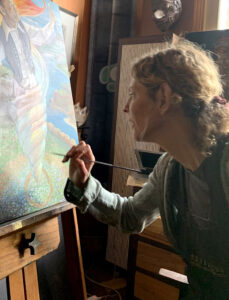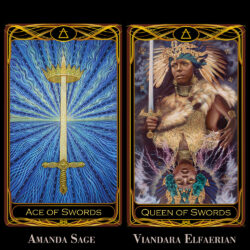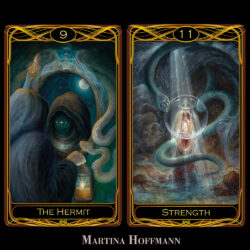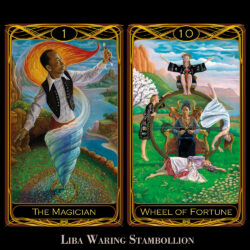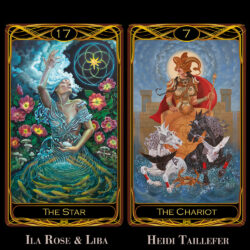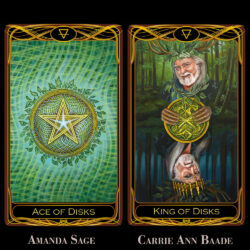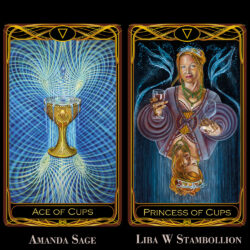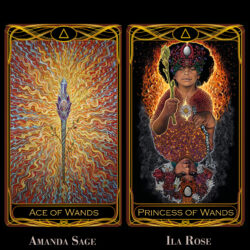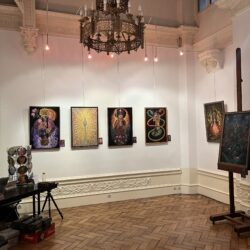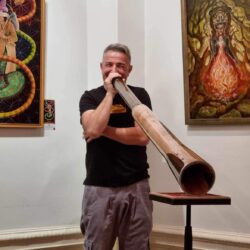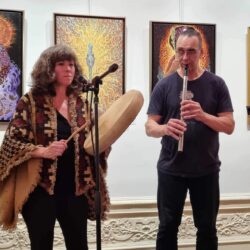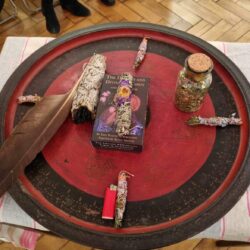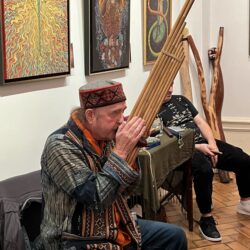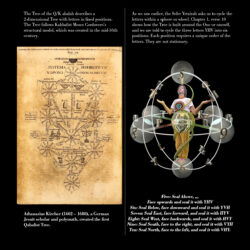Q: How did you choose your partners in the tarot project?
A: Like all my Dreams & Divinities projects, this happened organically. Initially, the idea of making a collective deck had been discussed with artists Carrie Ann Baade and Michel Bassot, but I wasn’t quite sure how to do it. Having just wrapped up the Fernal Encyclopedia project with nearly 120 artists, the next project called for something more intimate. The answer came when artist Martina Hoffmann approached me with the proposition of writing a book for a Tarot deck she intended to make. It was decided then and there to create a small collective deck with all four artists. Unfortunately, Michel fell ill and was unable to finish the cards.
Thus, a replacement had to be found, and four other female artists were chosen to join the deck. The decision was made after careful consideration and discussion with Martina and Carrie to ensure that everyone felt comfortable with the new Taroistas.
Q: With some, or all, of your partners in Dreams and Divinities, you had lucid dreams which
were connected or similar, that you would discuss, could you tell us what was most significant about that connection?
A: Most of my dreams about the Tarot concerned the system that it was based on. The Sefer Yetzirah, an ancient Hebrew esoteric system, was studied by Christian Cabalists and Hermetic Qabalists during the inception of the Tarot. It is highly probable that their system was used as the structure for the Tarot. Interestingly, I started dreaming about the Sefer Yetzirah years before discovering it. I have had countless dreams about it since I began working with it eight years ago. Dreams have helped me solve the shape of its Tree and its origins. Martina Hoffmann had a dream about the deck that we all enjoyed. We had been deciding whether to print 1000 decks or 777 decks. We wanted the 777 number because of the impact the number 7 has had on our project, but it was cheaper per deck to print 1000. The night of our conversation, she dreamt that the artist editions we would receive for our work in the project should not be counted in the edition of 777. She was shown in her dream that we had 223 artist editions, 777+223 = 1000. And that 2+2+3 = 7.
Q: You have also been working on a book that deals with the meaning behind the cards, tying the ancient knowledge of the Kabbalah to the Tarot. How does the Tree of Life relate to the Tarot?
A: The Tarot and the Tree show too many similarities to be non-intentional. Kabbalism, the study and interpretation of traditional Hebrew mystical texts, was in vogue when the 78-card deck emerged in Italy in the 15th century. Two contemporary movements to the emergence of the Tarot were Christian Cabalism and esoteric Qabalism, which interpreted the Kabbalah through their own lens. It seems undeniable that their philosophy helped form the Tarot deck we have today.
The first Kabbalist Tree was created in the mid-16th century by a renowned Kabbalist named Moses Cordovero. He created his Tree by studying and interpreting the opinions of his contemporaries, the midrash, and the Kabbalist texts. The oldest book in the collection is the Sefer Yetzirah. It describes a Universal body or Tree made of 22 letters and 10 spheres.
Despite the philosophy of Cordovero’s Kabbalist Tree being based on many sources, the structure of the Tree was based on these letters and numbers. This little text, originally an oral tradition, was first mentioned in the Babylonian Talmud around 450 CE. This made it at least one thousand years older than Cordovero’s Tree and centuries earlier than Kabbalism itself. Even though Cordovero created his Tree a century after the first Tarot decks emerged, later occultists would directly associate the 22 Hebrew letters with a later Qabalistic version of this Tree rather than the Sefer Yetzirah itself. This confusion was more than just a historic mistake.
It created a new philosophy around the cards, which works in itself but neither truly reflects the traditional viewpoint nor my own.
Q: It is commonly believed that the Tarot was created in the mid-15th century Italy around
1430. Do you believe that is true, or is this system of divination much older?
A: Yes, the common opinion is that it emerged in the 15th century in Italy. There is some dispute concerning the Charles VI deck, which could have been created in the late 14th century. I believe the philosophy of the cards is much older than the Renaissance, but I doubt the cards were. We can see a historical development of them in Italy.
Q: In the 18th century, a Frenchman Jean-Baptiste Alliette wrote a book linking tarot cards to divination. It is believed that he assigned meaning to each card, leaning on astronomy and the elements and taking inspiration from the Egyptian Book of Thoth. What is your opinion about this?
A: The Tarot arrived in the 15th century without card titles, numbers or a guidebook. By the 18th century, scholar and author Court de Gebelin and Eteilla decided that the cards had an Egyptian origin and were initially called the Book of Thot. The story had it that the images had been painted on 78 sheets of gold and, therefore, had survived the burning of the library of Alexandria. There has never been any proof that this book of Thot ever existed. Nevertheless, this idea has had a significant impact on Tarot up to this day.
Gebelin took it further and claimed that the 22 trumps were synonymous with the 22 Hebrew letters. I totally agree with this. He believed the letters were connected to the Egyptian hieroglyphs, an idea most likely from Athanasius Kircher, who had associated the two and was later proven to be right. The 22 Hebrew letters that make up the Tree of Life (Sefer Yetzirah or K/Qabbalist) are already associated with the 12 constellations, the 7 planets, and the elements. Eteilla gave us the first guidebook called the Grand Eteilla. I personally am not a big fan of it neither was the renowned occultist Papus who came after him. His descriptions are unfocused, often superficial and finding the essential meanings is difficult.
Q: Some historians have questioned the use of the Tarot as a divination tool before the 18th century, are there a clues in the court cards that might tie the Tarot to pagan sources?
A: It’s true, we have no proof that Tarot was ever initially used for divination. Eteilla was really the first one to make divination popular with Tarot. Because of the Hermetic influences on the Tarot in the 15th century, there are many pagan references in the cards. Like the letters in the Sefer Yetzirah, these deities represented aspects of the Soul and astrology.
Q: Scholars have guessed that the origins of the Tarot actually trace back to ancient China, Egypt, India or Persia. If that is true, would they not have had their own idea of what the cards symbolized and how they were to be used?
A: Historically, they emerged in Italy during the Renaissance when Pagan, Egyptian, and esoteric ideas were all in vogue.
Q: What are your thoughts on the mystical influences that led to the creation of Tarot?
A: They seem clearly to have their root in Christian and Hermetic Kabbalism.
Q: Is it true that common playing cards have a connection to the Tarot? It is called Cartomancy.
Do you have an opinion about how these two developed or came into use? (In that system, Spades are similar to swords in Tarot representing communication and challenges. Hearts are like cups in Tarot depicting emotions, family, home, and relationships. Clubs are like wands in Tarot, defining change and action. And Diamonds are like disks or pentacles in Tarot and are about money, confidence, and finances.)
A: Yes absolutely. In the Tarot, these cards are called the pips. The first known deviation from cards for gambling to cards for moral speculation was in Europe in the 14th century. This is seen in the 1377 treatise written by Brother Johannes von Rheinfeld: Treatise of morals and instruction of human conduct, moralizations on the Game of Cards. At that time, the 78 deck had not been developed, but clearly, the pips were already in development.
Q: Could playing cards have been used as a disguised form of divination, but then eventually
devolved into game use?
A: Historical evidence points to cards being used for games before mystical speculation or divination. However, a few Renaissance authors said they were the first cards invented. It is a good question and still unclear to scholars. The Tarot definitely indicate a hermetic system hidden under symbols of the law and church. This does not mean that there were no Christian influences, but having a female Pope (eventually called the High Priestess) was not only unheard of but heretical. She and the Empress hold a higher number: 2 & 3 than their spouse, who are paired 4 & 5. This also was not in line with the church, and indicates hidden symbolism.
Q: Did you personally guide the artists regarding the symbolism that each card should contain, or did you leave it up to them to interpret what they felt the card should represent?
A: Pretty much all the artists consulted with me. I wanted them to interpret the cards with their hearts but based on the collective egregore of the card.
Q: Tell us more about how you worked with your team of artists to create this magnificent deck. It seems like it must have been an enormous undertaking.
A: I guess that’s why it took seven years, LOL. The first 6 ½ years were easy and in the flow. I think we were all excited to delve into the mystery of the cards. The last 6 months were one of the most challenging periods of my life. The birthing pains were huge. We finally had a launch date, and we had to complete the paintings, get them photographed for the deck, and frame them for the show. I also needed to do the 2-10 of the minor arcana. Working with the printer was highly time-consuming. I worked around the clock as an artist, writer, designer, and producer. It was a strenuous period for friendships because I had no social time, and of course, with all that happening at once, I got sick for three weeks once the deck and show were launched. Lol. But like a baby who finally is born, the final product made it all worthwhile.
Q: The cards were created as large paintings that are now part of a traveling art show, please tell us about where you have shown them and what are the plans for future shows?
A: The Tarot deck and its original paintings were officially launched on December 5th at the historic Atelier Gustave in Paris at 36 Rue Boissonade, 75014 Paris. The week of events included a blessing of the deck with our first reading, which concerned our direction for the planet’s well-being. There were concerts and a conference from the lovely Taroista, Delphyne Veyrat.
The next stop is this March 9th and 10th; I will present the Dreams & Divinities Tarot along with a few original paintings and offer a conference at the Salon d’Oracle et du Tarot in beautiful Bretagne (Brittany France).
Immediately after the Salon, Galerie 18bis, Paris, will launch ‘The Tree and the Tarot’, my first book in a trilogy about the Hebrew esoteric system, the Sefer Yetzirah.
For those in the Paris region, here is the schedule:
March 14th– Book launch and opening.
March 21st – A collective Tarot reading and mandala offering for the Equinox.
March 29th – Presentation: The Tree and the Tarot – an exploration into the intricate connections between the oldest Hebrew esoteric text: the Sefer Yetzirah, the Tarot, and the ancient wisdom underlying them.
In August and September, we will have the whole show (minus pieces sold) in a beautiful castle that is part of the Naia Museum and also in Brittany. We have yet to set the exact dates. Some lovely possibilités in the USA are inviting …I am excited to see what unfolds from them as well!
Q: You designed the Magician in the Dreams and Divinities deck. As an example, can you take us through your process of determining what to include in the symbology of this card?
A: The posture of the Magician is based on my association with the Mother letter Aleph. (An
association most decks make as well). This letter is symbolized by the indivisible number of one. She represents the Source, who creates the magical illusion of life in all its multiplicity.
She is a true Virgin Goddess, meaning none came before her to impregnate her. Concerning her, the Sefer Yetzirah asks us, “And what do you count before one?”
Since the 18th century, this card classically depicts the Magician holding one hand up and one hand towards the table or earth. This gesture expresses the 8th-century axiom “As above, so below.” It also describes the Sefer Yetzirah’s fractal nature, “As inside, so without .” The Magician mimics the form of the letter Aleph, which has a central diagonal line with one upward-pointing Yod (a small letter in the aleph-bet) on the right side and a downwards- pointing Yod on the left. In its form, it has the primal polarity and its synthesis. It encompasses the un-manifest trinity.
The Magician has the four tools represented in the minor arcana. Each one is associated with one of the four elements:
The sword – Air – intellect -mind
The chalice – Water – emotion -heart
The wand – Fire – will and action
The discs/pentacles – Earth -– manifestation
When I painted the Magician, I did not include all four tools, but I did include all four elements.
Q: What comes next?
A: Alongside the Tarot deck, I have been working on a trilogy about the Sefer Yetzirah. The first book, The Tree and the Tarot will be launched on March 14th at Galerie 18bis in Paris. This trilogy was inspired by three questions concerning the origins, the form, and the impact of the Sefer Yetzirah.
1) If the Sefer Yetzirah is attributed to Abraham, why are three Mothers the Primal Creators of the cosmos?
2) If the text asks us to cycle the letters in a wheel or a sphere, why isn’t the Tree spherical?
3) If the Tarot came out 100 years before the Kabbalistic Tree, why are they so similar?
The other two books will be coming out later this year!
Check out Liba’s websites:
https://www.artwork-liba.com/
http://www.dreamsanddivinities.com/



